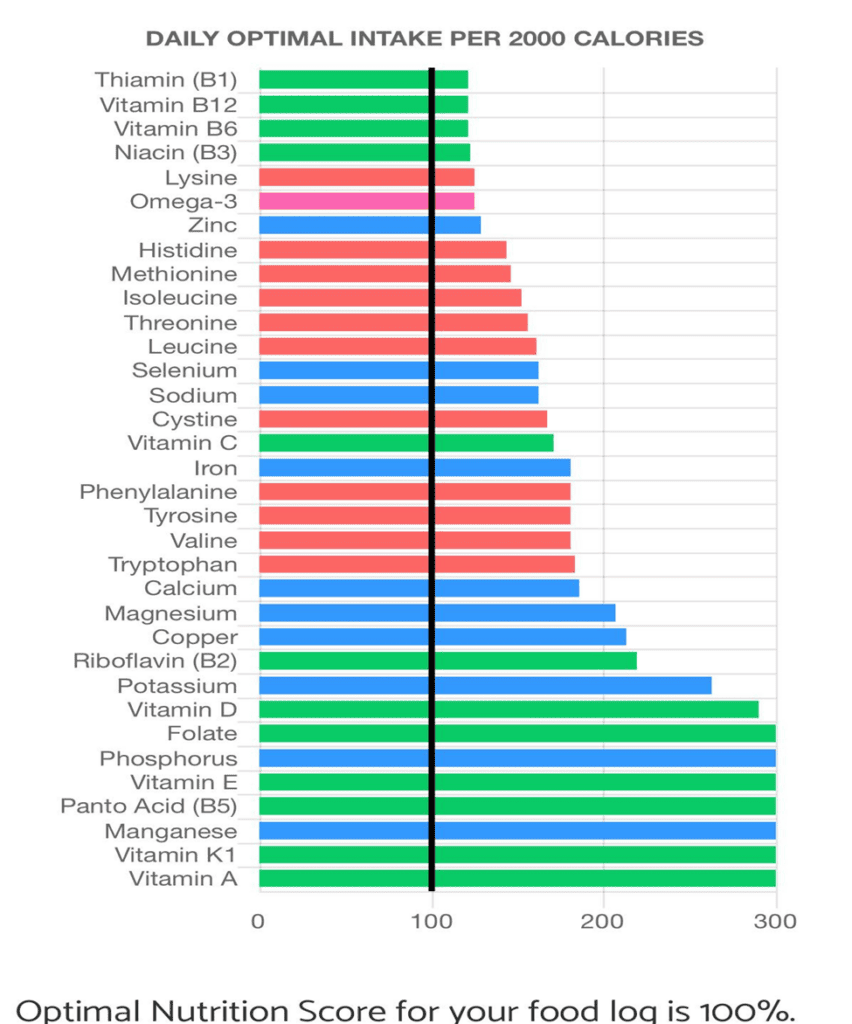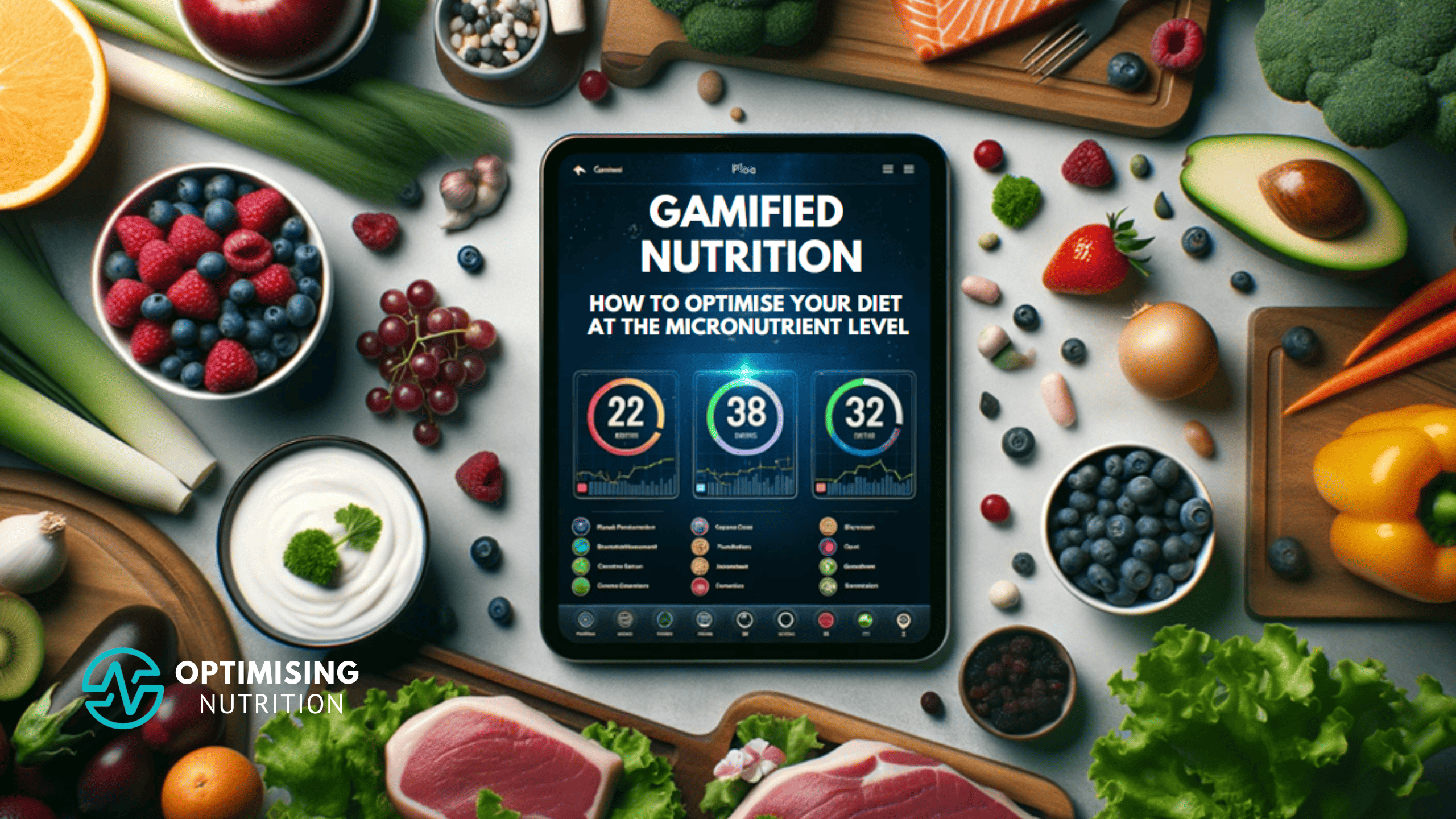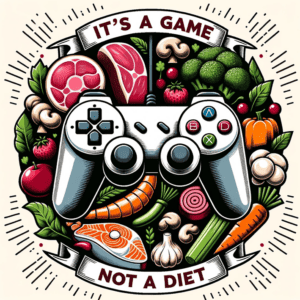Embark on a journey where wellness meets play in the realm of gamified nutrition. As you step into a world crafted to optimise your well-being, you’ll discover the beauty of personalised nutrition tailored to your body’s unique needs.
This is more than just another diet — it’s the game of nutritional optimisation, where each meal is a mission and every nutrient a treasure you can unlocked.
Precise, personalised nutrition is your map in this engaging quest, guiding you through a landscape where every bite brings you closer to your health goals. The path to vitality has never been this enjoyable.
Just as a pantry needs a good balance of ingredients to whip up a satisfying meal, your body requires a balanced intake of these nutrients to function optimally.
In this enlightening exploration, we introduce you to a gamified approach to nutrition, turning the often-tedious task of maintaining a balanced diet into an engaging challenge.
Ready to level up your health in the most enjoyable quest you’ll ever undertake? Your adventure of taste and vitality awaits!
- Introduction to Gamified Personalised Nutrition
- Playing the Macro-Micronutrient Game: Gamify Your Body’s Pantry
- The Dual-Fuelled Engine of Your Body: A Precision Nutrition Perspective
- Protein Power-Up: Building Your Avatar’s Strength
- Mineral Mastery: Powering Your Quest
- Vitamin Victory: Unlocking Metabolic Magic
- Your Precision Nutrition Dashboard
- Whack-A-Mole Micronutrient Management: Gamifying Nutritional Balance
- Your Avatar’s Journey: Gamifying Your Progress
- Meet the Monsters in the Game of Nutrition
- Precision Nutrient Filling
- The Secret to Winning the Game of Nutritional Optimisation
- NutriBooster Recipes: Power Packs for Your Nutritional Game
- From DRIs to ONIs: Leveling Up Your Nutrient Targets
- Leaderboard to Wellness: Scoring Your Nutritional Game
- The Matrix of Nutrition
- Winning Strategies: Precision Nutrient Filling and Beyond
Introduction to Gamified Personalised Nutrition
Picture your body as a well-organised pantry, where each container holds essential nutrients – from macronutrients like proteins, fats, and carbs to micronutrients, including vitamins and minerals tailored to meet your body’s unique nutritional needs.

As you peer into the pantry, you see:
- large containers holding bulky, frequently-used items – these are the macronutrients (i.e., protein, fat and carbs),
- smaller jars containing the minerals and
- teeny tiny canisters of vitamins, so small that the human eyes can scarcely see them and their vital contents.
Imagine each storage compartment inside your ‘perfect human pantry’ is clearly labelled for easy organisation, use, and efficiency.
As the containers empty, your body immediately senses which ones need refilling. Like the latest AI-empowered fridge, your super-efficient survival instincts put in an order for what it needs, and your appetite drives you to search for the foods and meals that contain the macronutrients and micronutrient goals on the shopping list.
Playing the Macro-Micronutrient Game: Gamify Your Body’s Pantry
Are you ready to play the game?
Awesome!
But first, you need to learn the rules.
The two largest buckets in your human ‘pantry’ are your fuel tanks – glucose and fat. They could be likened to Monopoly’s Boardwalk and Park Place because they are the most expensive to own, fill, maintain, and operate.
The biggest bucket contains fat, and the second largest holds glucose. While each fuel is best used in different situations — the carbs support explosive activities, and the fat is your default fuel at rest — either fuel can meet your body’s energy requirements.

The Dual-Fuelled Engine of Your Body: A Precision Nutrition Perspective
Understanding the capacity of the fuel tanks that fuel your body’s dual-energy metabolism is critical to skilfully gamifying your nutrition. This precision nutrition perspective empowers you to manage your energy resources efficiently so you can win.
You can store about 2,000 calories of energy as glucose in your liver, muscles, and blood —about a day’s worth of fuel. Meanwhile, you can stockpile a massive—but not infinite—amount of energy in your fat tank.
- A lean person might maintain around 40,000 calories worth of fat (4 kg or 10 lbs.).
- Meanwhile, a larger person could store up to half a million calories of energy as body fat!
Our fat and glucose fuel tanks are separate but somewhat interconnected – your body can convert one form of fuel to another if necessary.

However, due to Oxidative Priority and your limited capacity to store glucose, your body has to use any excess glucose before metabolising the fat on your body and in your blood. You must use the upstream fuels before accessing your body fat.
Protein Power-Up: Building Your Avatar’s Strength
Protein can be used in an emergency, but it’s an inefficient energy source. A significant amount of energy (20 to 35%) is lost in converting dietary protein into energy for your body.
Rather than energy, your body primarily uses the protein you eat to build and repair your muscles, make neurotransmitters, and perform many unique and critical body functions.
Protein is made up of nine essential amino acids – as illustrated in the image below from Cronometer.
Imagine that as you fill each amino acid ‘container’, your body powers up with strength in your gamified quest. Thus, micronutrient tracking empowers you to make informed dietary decisions.
Mineral Mastery: Powering Your Quest
Minerals are smaller than amino acids, measured in micrograms, milligrams, or grams, depending on the mineral.
Minerals help transfer energy throughout the body, similar to how wires in your car distribute power from the battery.
Minerals also work synergistically with vitamins to enable you to use the energy from fats and carbs, ensuring a perfect nutrient balance for optimal function. Precision nutrition helps in tweaking the intake of these crucial minerals to meet your body’s specific needs.
Again, you can track the minerals in your diet to ensure you are keeping them all topped up with nutrient-rich foods.
Vitamin Victory: Unlocking Metabolic Magic
Vitamins are the organic compounds the body needs to carry out its essential metabolic processes. Similar to minerals, essential vitamins cannot be produced by the body and must be obtained from food.
Exploring the synergy between vitamins and minerals can unlock new levels in your nutrient game. Precision nutrition guides you to balance these micronutrients to enhance metabolic processes.

The amount of vitamins we need is even smaller than the minerals – some can only be measured in micrograms. But tiny as they are, vitamins are still essential!
The B vitamins often come bundled with protein, while others are more plentiful in plant-based foods (e.g., folate, K1, and C). So, gamifying your vitamin intake may lead you on a fresh quest in search of new foods to broaden your palate.
But tiny as they are, vitamins are still essential! As you monitor your food intake, you become more adept at ensuring a balanced intake of these vital micronutrients.
Your Precision Nutrition Dashboard
Below, the diary view from Cronometer shows fuel in the form of fats and carbohydrates alongside the essential micronutrients. With this view, you can easily see which nutrient containers in your body’s pantry are full and which need to be topped up with nutrients to prevent deficiencies and ensure your body continues functioning at full power.
Whack-A-Mole Micronutrient Management: Gamifying Nutritional Balance
As you progress, keeping ALL the nutrient containers topped up without overfilling your fat and carb fuel tanks becomes like a challenging game of Whack-A-Mole to prevent micronutrient deficiencies that could hamper your avatar’s progress.
While you’re busy focusing on topping up one nutrient, others pop up as higher priorities. When you start out, it’s not easy to balance your diet at the micronutrient level! But don’t worry! Your skill level will improve as you continue to play.

Over time, you become better at filling the buckets and lose yourself in dialling in the harder-to-find micronutrients. Then, one day, you look up and realise that with your perfect score, you’ve become a mini-me of the high rollers who do best at this ‘game.’

Congratulations! You’re a winner!
Your Avatar’s Journey: Gamifying Your Progress
Tracking your food can further enhance your understanding of nutrient intake. As you fill the buckets, your avatar grows in strength and vitality (not to mention good looks), embodying the essence of gamified personalised nutrition.

Eventually, you will have scored so many bonus nutrients that your avatar can reproduce cute avatar babies. And, so, the happy cycle continues.
That is unless you interrupt the storybook ‘happily ever after’ by failing to keep your containers topped up, and your appetite becomes an out-of-control dumpster fire!

Meet the Monsters in the Game of Nutrition
Like those lurking in the scariest, creepiest games, our game of optimising your nutrition has a monster you must keep happy by following the rules — a terrifying Hunger Monster (aka your lizard brain, Lizzy, or amygdala). Lizzy roars into action if you lose focus or fudge your scores and you binge indiscriminately.

When challenged with basic survival, all Lizzy cares about is filling your energy fuel tanks with as much fuel (from fat and carbohydrates) as possible so your avatar doesn’t die. It’s an emergency!
To make things worse, Lizzy also knows she needs to fill the other vitamin, mineral and protein reserves, so she gorges on even more of your fat+carb combo kryptonite foods to get the micronutrients she needs to survive.
But it’s a hopeless, hapless strategy. Sadly, because of her poor food choices, Lizzy doesn’t do a good job keeping all the containers full. So, before long, your avatar loses strength, health, and vitality (not to mention becomes pudgy and lethargic) over time.
Game over?

Nope!
Precision Nutrient Filling
We’ve created some winning additions to the playbook to help you attain personalised nutrition excellence! Precision nutrient filling is the next step in your gamified nutritional quest.
After spending a LOT of time trying to crack the code and help people win this game, we realised it was impossible to win if you only focused on one nutrient at a time.
Some players resort to supplementation to hit their nutrient targets, but we advocate for a food-first approach whenever possible. While it’s easy to pack vitamins and maybe a few smaller minerals into a pill, you need to balance all the micronutrients simultaneously. Lizzy doesn’t care too much for fake vitamin pills and powders. She sees these as an unholy sacrifice. What she craves to keep her content and satisfied is the protein and minerals that come with real food.
The Secret to Winning the Game of Nutritional Optimisation
So what’s the secret to a Nutritional Optimisation homerun?
Do you want to know our ‘secret’ discovery—the game changer?
You need to get all the essential nutrients from the food you eat in the form and ratios that your body understands.
Remember those containers at the beginning of this article? Imagine them as a row of glasses lined up, ranging from empty at one end to full at the other.

With your nutrient containers lined up from empty to full, you can simply focus on filling the containers running low. As you learn to more efficiently fill your current priority nutrient containers, you can re-shuffle the containers to focus on those that need refilling.
That’s what we’ve done in Nutrient Optimiser to help you manage your micronutrients.
The chart below shows an example of the thirty-four essential micronutrients from a week of food logging.
- The x-axis is the percentage of the Recommended Dietary Intake or the minimum amount of each nutrient required to prevent diseases of deficiency.
- At the bottom, you can see this particular selection of foods provides plenty of nutrients like Vitamin A and K1.
- Meanwhile, we need to focus on the nutrients at the top of the chart, like vitamin D, zinc, calcium, vitamin B1, and magnesium).

NutriBooster Recipes: Power Packs for Your Nutritional Game
Imagine having a precise, custom-designed watering can that enables you to fill just your empty containers precisely.
That is what we’ve done with our suite of NutriBooster Recipes to provide innovative food combinations to ensure a balanced nutrient profile to help you win the game of nutrition.

The NutriBooster Recipes are designed to enable you to maximise nutrient density. After you’ve tracked your food in Cronometer for a few days, Nutrient Optimiser gives you a recommended shortlist of foods and meals that will provide you with the cluster of nutrients that your entries show you should focus on. Your food diary becomes a powerful tool in the optimal nutrition game.
Later, once you’ve dialled in your harder-to-find nutrients, the recommended foods and meals will be re-shuffled to focus on your new priority nutrients.
As you continue to ‘play,’ your nutrient score climbs—your avatar brims with health and vitality, ready to tackle any challenge.

From DRIs to ONIs: Leveling Up Your Nutrient Targets
As a beginner in personalised nutrition, you aim first to meet the minimum intake of all the essential nutrients your avatar needs to survive and prevent diseases stemming from deficiency.
But once you can check off the Dietary Recommended Intakes (DRI), you are ready to level up and shoot for the Optimal Nutrient Intakes (ONIs).
Rather than the minimum amount of each nutrient, the ONIs represent a ‘stretch target’ for each nutrient per calorie. This means they are a measure of food quality, regardless of food quantity.
However, unlike other approaches, you don’t necessarily need to eat more food to improve your score — it’s all about eating better.
The focus on nutrients per calorie empowers you to balance your nutritional needs at the micronutrient level without consuming more energy than you need, steadily filling your nutrition tracker with greener bars of achievement.
The chart below shows an example of a winning nutrient intake score. The x-axis is the Optimal Nutrient Intake per 2000 calories. You get a perfect score if you can fill in everything to the left of the black 100% line!

Leaderboard to Wellness: Scoring Your Nutritional Game
In addition to knowing that you have improved your diet quality score and nourished your body with all the nutrients it needs without excess energy, you can also win a place at the top of the leaderboard.

Of course, it’s not easy to achieve nutritional perfection, but many Optimisers do score a perfect 100% using Nutrient Optimiser in our Micros Masterclass.
The Matrix of Nutrition
The game becomes even more captivating as you learn to read your body’s subtle craving signals. Eventually, you begin to see beyond the numbers and understand what nutrient-dense food looks, tastes, and feels like.
You learn to listen to your body’s needs once you leave behind the fake flavours of modern manufactured food. You can fill your fridge and cupboard with healthy foods that work for you and then listen to your appetite for guidance on what to eat next!
Ultimately, once you learn to associate your craving with your body’s needs for the food it needs, you can leave your food tracking app behind!
Winning Strategies: Precision Nutrient Filling and Beyond
We have worked hard over the past five years to simplify this process and make it as easy as possible for Optimisers to win the game of nutritional optimisation.
Food Lists
If you’re starting out and not yet meeting your minimum nutrient requirements, it’s best to begin with foods and meals that contain more nutrients per serving. But once you meet the minimum nutrient intake, you can progress to focus on nutrient-dense foods that contain more of all the nutrients per calorie.
You can kickstart your nutrient game today with our simple food lists in our Optimising Nutrition Community here.

The Healthiest Meal Plan in the World
Rather than trying to follow an off-the-shelf meal plan, we find that most people have the most long-term success when they evolve their current eating method into a nutrition-packed masterpiece.
But if you want to see what a week of nutrient-dense eating could look like, download our free Healthiest Meal Plan in the World here.

Your NutriBooster Recipes: Power Packs for Your Nutritional Game
But most of us don’t just eat individual foods; we combine them to make meals. We created our suite of 35 NutriBooster recipe books to help Optimisers with different goals and preferences get the micronutrients they need from tasty recipes.
The NutriBooster recipe books are ideal for people who don’t want to track their food and want to know what to eat to get the necessary nutrients. To kickstart your nutrition game, you can download samples of each book here.

Starting Your Gamified Nutrition Quest: Free 7-Day Tracking Challenge
If you’re curious and want to see how your personalised nutrition stacks up, we’d love you to take our free 7-Day Nutrient Clarity Challenge. After a few days, Nutrient Optimiser will reveal your nutrient score, identify which foods from your current diet are more and less optimal for you, and provide food and meal suggestions to align closer to your micronutrient goals.
Micros Masterclass
Once you’re ready to level up your nutrition game, we’d love you to try our Micros Masterclass. Over four weeks, we’ll show you how to plug the gaps in your current diet and play the nutrient bucket-filling game to take your nutrition to the next level. We’ll show you the ropes of effective meal planning to make your nutrient bucket-filling game a resounding success. You can even compete for a spot on our nutrient-density leaderboard.









?Best Game Ever!!?